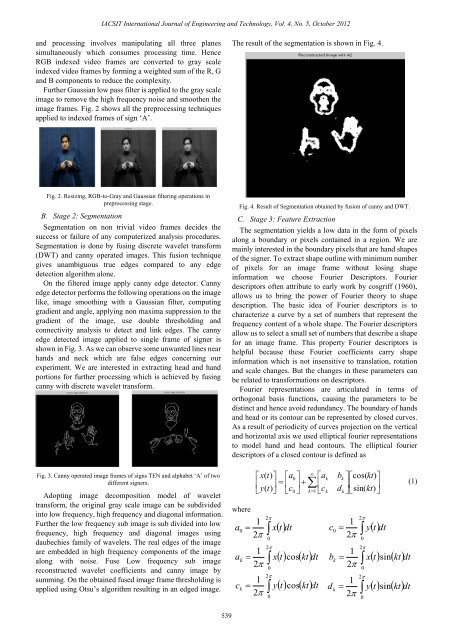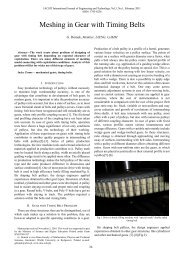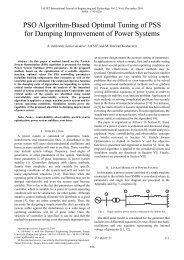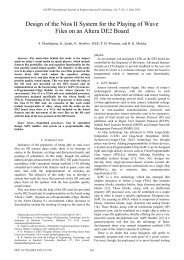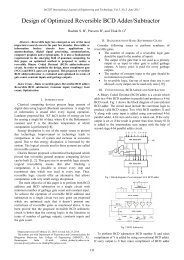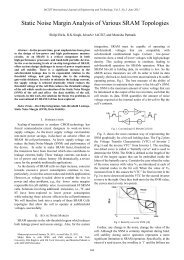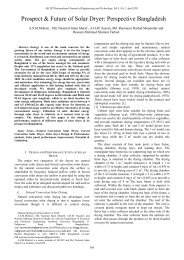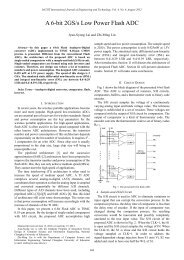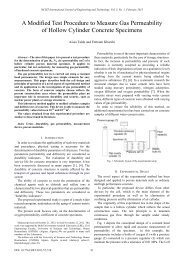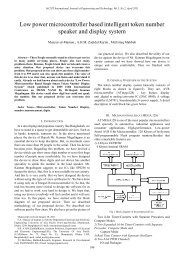A Video Based Indian Sign Language Recognition System ... - IJET
A Video Based Indian Sign Language Recognition System ... - IJET
A Video Based Indian Sign Language Recognition System ... - IJET
You also want an ePaper? Increase the reach of your titles
YUMPU automatically turns print PDFs into web optimized ePapers that Google loves.
IACSIT International Journal of Engineering and Technology, Vol. 4, No. 5, October 2012<br />
and processing involves manipulating all three planes<br />
simultaneously which consumes processing time. Hence<br />
RGB indexed video frames are converted to gray scale<br />
indexed video frames by forming a weighted sum of the R, G<br />
and B components to reduce the complexity.<br />
Further Gaussian low pass filter is applied to the gray scale<br />
image to remove the high frequency noise and smoothen the<br />
image frames. Fig. 2 shows all the preprocessing techniques<br />
applied to indexed frames of sign „A‟.<br />
The result of the segmentation is shown in Fig. 4.<br />
Fig. 2. Resizing, RGB-to-Gray and Gaussian filtering operations in<br />
preprocessing stage.<br />
B. Stage 2: Segmentation<br />
Segmentation on non trivial video frames decides the<br />
success or failure of any computerized analysis procedures.<br />
Segmentation is done by fusing discrete wavelet transform<br />
(DWT) and canny operated images. This fusion technique<br />
gives unambiguous true edges compared to any edge<br />
detection algorithm alone.<br />
On the filtered image apply canny edge detector. Canny<br />
edge detector performs the following operations on the image<br />
like, image smoothing with a Gaussian filter, computing<br />
gradient and angle, applying non maxima suppression to the<br />
gradient of the image, use double thresholding and<br />
connectivity analysis to detect and link edges. The canny<br />
edge detected image applied to single frame of signer is<br />
shown in Fig. 3. As we can observe some unwanted lines near<br />
hands and neck which are false edges concerning our<br />
experiment. We are interested in extracting head and hand<br />
portions for further processing which is achieved by fusing<br />
canny with discrete wavelet transform.<br />
Fig. 3. Canny operated image frames of signs TEN and alphabet „A‟ of two<br />
different signers.<br />
Adopting image decomposition model of wavelet<br />
transform, the original gray scale image can be subdivided<br />
into low frequency, high frequency and diagonal information.<br />
Further the low frequency sub image is sub divided into low<br />
frequency, high frequency and diagonal images using<br />
daubechies family of wavelets. The real edges of the image<br />
are embedded in high frequency components of the image<br />
along with noise. Fuse Low frequency sub image<br />
reconstructed wavelet coefficients and canny image by<br />
summing. On the obtained fused image frame thresholding is<br />
applied using Otsu‟s algorithm resulting in an edged image.<br />
Fig. 4. Result of Segmentation obtained by fusion of canny and DWT.<br />
C. Stage 3: Feature Extraction<br />
The segmentation yields a low data in the form of pixels<br />
along a boundary or pixels contained in a region. We are<br />
mainly interested in the boundary pixels that are hand shapes<br />
of the signer. To extract shape outline with minimum number<br />
of pixels for an image frame without losing shape<br />
information we choose Fourier Descriptors. Fourier<br />
descriptors often attribute to early work by cosgriff (1960),<br />
allows us to bring the power of Fourier theory to shape<br />
description. The basic idea of Fourier descriptors is to<br />
characterize a curve by a set of numbers that represent the<br />
frequency content of a whole shape. The Fourier descriptors<br />
allow us to select a small set of numbers that describe a shape<br />
for an image frame. This property Fourier descriptors is<br />
helpful because these Fourier coefficients carry shape<br />
information which is not insensitive to translation, rotation<br />
and scale changes. But the changes in these parameters can<br />
be related to transformations on descriptors.<br />
Fourier representations are articulated in terms of<br />
orthogonal basis functions, causing the parameters to be<br />
distinct and hence avoid redundancy. The boundary of hands<br />
and head or its contour can be represented by closed curves.<br />
As a result of periodicity of curves projection on the vertical<br />
and horizontal axis we used elliptical fourier representations<br />
to model hand and head contours. The elliptical fourier<br />
descriptors of a closed contour is defined as<br />
where<br />
x(<br />
t)<br />
a<br />
<br />
y(<br />
t)<br />
c<br />
2<br />
1<br />
a <br />
x<br />
0<br />
2<br />
0<br />
2<br />
1<br />
a k<br />
<br />
2<br />
x<br />
c k<br />
1<br />
<br />
2<br />
0<br />
2<br />
<br />
0<br />
y<br />
t<br />
dt<br />
0<br />
0<br />
<br />
<br />
ak<br />
bk<br />
cos( kt)<br />
<br />
<br />
k 1 ck<br />
dk<br />
sin(<br />
kt)<br />
<br />
t<br />
cosktdt<br />
t<br />
cosktdt<br />
c<br />
0<br />
1<br />
<br />
2<br />
2<br />
<br />
0<br />
2<br />
y<br />
1<br />
b k<br />
<br />
2<br />
x<br />
d k<br />
1<br />
<br />
2<br />
0<br />
2<br />
<br />
0<br />
y<br />
t<br />
dt<br />
t<br />
sinktdt<br />
t<br />
sinktdt<br />
(1)<br />
539


